悉尼歌剧院2
澳大利亚悉尼歌剧院
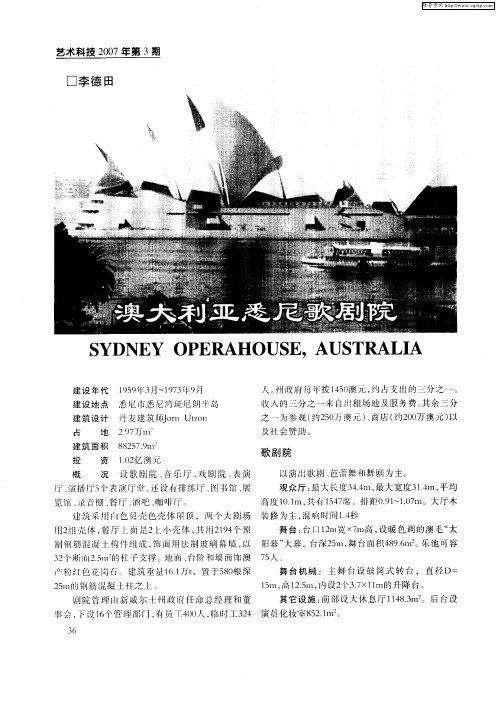
表演 厅
用来 演 出话 剧 、 率内乐 , 举办讲 座 、 议和放 映 会 容积2 0 0 , 响时 问20 。演 奏 台 空 高2 m, 电影。有 座席3 8 , 8 0 m 混 . 秒 5 9 个 大厅用 白桦 木胶 合板装 修 , 混 悬 有 1个 可蒯 的圆圈形有 机玻 璃声扩 散体 。 厅 的 响时 间0 秒 。 8 大 . 7 上部 墙而饰 白伴 木板 ,下 部墙 面 及 台 面饰 黄杨 木
4. 息 厅 a 休
5管 风 琴 .
6音 乐 厅 . 7排 练 厅 .
1m, 1 .n 内设2 .x l 5 高 25 , 1 个37 1m的升 降 台。 其它 设施 : 前部 设 大休 息厅 14 . 。后 台设 83 1 m
剧 院管 理 由新 威尔 十 州政 府 任命 总经 理 和董
5 .1。 11 事会 , 发1 个管 理部 门 , 员 T4 0 , 下 6 有 0 人 临时工3 4 演员化 妆窜8 211 2
建设 地点 悉尼 市悉尼 湾斑尼 朗半 岛
收入 的三 分之一 来 自 租 场地 及服务 费。 其余 三分
之一 为参观 ( 5 万 澳元 ) 商店 ( 0 万 澳元 ) 约2 0 、 约2 0 以
及社 会赞助 。
建筑 设计
占
建筑面 积
丹麦 建筑师Jr zn on Ut o
8 2 791 8 5 .11 1
维普资讯
艺术 科技 2 0 0 7年第 3 期
口李 德 田
S YDNEY OPERAHOUS E,AUS TRALI A
建设 年代 1 5 年3 17 年9 9 9 月 ̄ 93 A 人 。 政府 每年拔 15 澳元 , 占支 出的三分之 一 。 州 40 约
悉尼歌剧院参观攻略

悉尼歌剧院参观攻略悉尼歌剧院是澳大利亚最著名的建筑之一,也是世界上最负盛名的音乐表演中心之一。
其独特的外观和丰富多样的演出吸引了来自世界各地的游客。
如果你计划参观悉尼歌剧院,下面是一些攻略,可以帮助你充分享受参观的过程。
1. 提前购买门票参观悉尼歌剧院前,请务必提前购买门票。
门票可以在线预订,可以通过悉尼歌剧院官方网站进行购买。
提前购票可以避免排队等待,并且确保你能参观到自己喜欢的场馆或演出。
另外,购买门票前最好了解一下悉尼歌剧院当天的演出安排,这样可以更好地规划行程。
2. 参加导览悉尼歌剧院为游客提供导览服务,可以选择参加导览,了解更多关于悉尼歌剧院的历史和建筑特点。
导览通常包括参观大剧院和小剧院,向游客展示这个壮丽建筑的内部结构和设计。
3. 欣赏演出悉尼歌剧院以其世界一流的演出而闻名,所以不要错过机会欣赏一场精彩的演出。
提前了解演出计划,并在购票时选择一场自己感兴趣的演出。
这里有各种类型的表演节目,包括音乐会、芭蕾舞、歌剧等,务必选取适合自己品味的节目。
4. 参观观景台悉尼歌剧院有一个名为“观景台”的地方,从那里你可以看到壮观的悉尼港和海港大桥。
观景台位于歌剧院的顶层,可通过电梯或楼梯抵达。
在观景台上,你可以尽情欣赏悉尼的美景,拍摄令人难忘的照片。
5. 参观博物馆和展览除了观赏演出,悉尼歌剧院还有自己的博物馆和展览空间。
这些空间展示了悉尼歌剧院的历史和其在世界音乐文化中的地位。
在博物馆里,你可以了解歌剧院的建筑背后的故事,探索其与澳大利亚文化的联系。
6. 尝试餐饮悉尼歌剧院内有多个餐厅和咖啡馆,提供各种美食和饮品。
你可以在这里品尝到当地和国际美食,并在就餐时欣赏美丽的海景。
不论是中午用餐还是晚上用餐,在歌剧院的餐厅里享受一顿饭是一种独特的体验。
7. 悉尼歌剧院附近的景点悉尼歌剧院位于悉尼市中心,所以你可以利用参观歌剧院的机会,顺便游览周边景点。
例如,你可以步行前往悉尼海港大桥,欣赏桥梁的壮丽景观,或者参观悉尼皇家植物园,享受大自然的美丽。
悉尼歌剧院演出推荐

悉尼歌剧院演出推荐悉尼歌剧院,位于澳大利亚的悉尼市中心,是世界著名的建筑之一,也是悉尼的地标性建筑。
作为全球最重要的表演艺术中心之一,悉尼歌剧院每年都会举行各种精彩的演出。
下面将为您推荐几场近期值得观看的歌剧院演出。
1.《卡门》《卡门》是一部由法国作曲家乔治·比才创作的著名歌剧。
它讲述了一段充满激情和命运的爱情故事。
这部歌剧融合了传统的歌剧音乐和西班牙风格的舞蹈,充满了浪漫和戏剧性。
悉尼歌剧院即将上演的《卡门》将由一支杰出的国际阵容带来,包括世界级歌唱家和舞蹈演员。
这将是一场视听盛宴,绝对不容错过。
2.《魔笛》《魔笛》是著名作曲家莫扎特创作的歌剧,被誉为歌剧中的瑰宝。
它讲述了王子塔马伊诺的冒险故事,充满了神秘、幻想和音乐的魔力。
这部歌剧结合了戏剧、音乐、舞蹈和幻术,将带给观众一场充满奇幻色彩的视觉和听觉盛宴。
悉尼歌剧院即将推出的《魔笛》将由具有丰富舞台经验的演员和乐团演奏家呈现,定会给观众带来无与伦比的艺术享受。
3.《音乐之声》《音乐之声》是一部感人至深的音乐剧,讲述了一位夫人和她的孩子们与音乐教师之间的温暖故事。
这部作品以其动人的音乐、精妙的编剧和出色的演员而闻名,深受观众喜爱。
在悉尼歌剧院的演出中,《音乐之声》将再次展现其魅力,并通过悉尼歌剧院独有的舞台和声效技术,为观众创造一个极具沉浸感的视听体验。
4.《天鹅湖》《天鹅湖》是世界著名的经典芭蕾舞剧,由俄国作曲家柴可夫斯基创作。
这部作品以其精美的音乐和优雅的舞蹈而闻名于世。
故事讲述了王子西奥朗恩与天鹅女皇奥德丽塔之间的爱情与悲剧。
悉尼歌剧院即将上演的《天鹅湖》将由澳大利亚国家芭蕾舞团呈现,他们将用精湛的技艺和令人难以置信的表演,展现这部经典作品的魅力。
以上只是悉尼歌剧院近期演出活动的一部分,每年还有更多精彩纷呈的表演将在这座世界级剧院中上演。
无论您对歌剧、音乐剧还是芭蕾舞有何喜好,悉尼歌剧院都能为您提供一场难忘的艺术盛宴。
预订您的门票,体验世界一流艺术的魅力吧!。
悉尼歌剧院(6.2班)PPT课件

03 悉尼歌剧院的演出活动
世界级的演
世界知名乐团演出
悉尼歌剧院经常邀请世界知名乐 团进行演出,如维也纳爱乐乐团、 伦敦交响乐团等,为观众带来世
界级的音乐盛宴。
国际知名艺术家
悉尼歌剧院还经常邀请国际知名 艺术家进行演出,如著名歌手、 舞蹈家、戏剧演员等,为观众呈
现高水平的艺术表演。
经典剧目
悉尼歌剧院上演的剧目多为经典 作品,如《卡门》、《图兰朵》 等,这些剧目经过时间的沉淀, 具有很高的艺术价值和观赏价值。
03
悉尼歌剧院的设计灵感来源于船帆和贝壳,其独特的外 观和内部结构使其成为世界上最著名的建筑之一。
设计理念
悉尼歌剧院的设计理念是由丹麦建筑师约恩·乌松提出的,他通过将传统与现代元素 相结合,创造出一个既具有澳大利亚特色又具有国际影响力的建筑。
乌松的设计灵感来源于澳大利亚的船帆和贝壳,他将这些元素融入到建筑中,使其 成为澳大利亚文化的象征。
悉尼歌剧院的建筑特色
02
独特的外观设计
01
独特的帆船造型
悉尼歌剧院的外观设计灵感来源于一组帆船,这种设计 使得它在悉尼港的背景下显得格外引人注目。
02
混凝土外壳结构
悉尼歌剧院采用混凝土外壳结构,这种结构不仅坚固耐 用,而且能够抵御风雨侵蚀,保持建筑的长久性。
03
建筑美学与功能性的结合
悉尼歌剧院的外观设计不仅具有美学价值,还充分考虑 了功能性,如独特的帆船造型有助于减轻风压对建筑的 影响。
定期举行的音乐会
音乐季演出
悉尼歌剧院每年都有音乐季演出,包括交响乐、室内乐、合唱音 乐会等,为观众提供丰富的音乐体验。
节日音乐会
在各种节日期间,悉尼歌剧院也会举行相应的音乐会,如圣诞节音 乐会、新年音乐会等,为节日增添浓厚的艺术氛围。
悉尼歌剧院中英文介绍
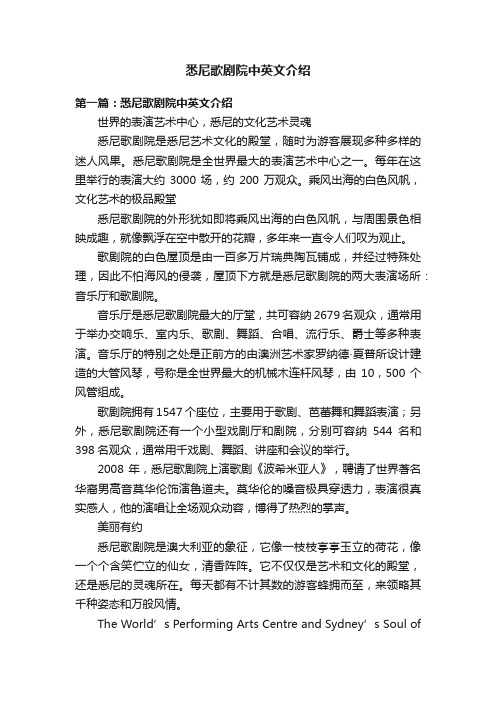
悉尼歌剧院中英文介绍第一篇:悉尼歌剧院中英文介绍世界的表演艺术中心,悉尼的文化艺术灵魂悉尼歌剧院是悉尼艺术文化的殿堂,随时为游客展现多种多样的迷人风果。
悉尼歌剧院是全世界最大的表演艺术中心之一。
每年在这里举行的表演大约3000场,约200万观众。
乘风出海的白色风帆,文化艺术的极品殿堂悉尼歌剧院的外形犹如即将乘风出海的白色风帆,与周围景色相映成趣,就像飘浮在空中散开的花瓣,多年来一直令人们叹为观止。
歌剧院的白色屋顶是由一百多万片瑞典陶瓦铺成,并经过特殊处理,因此不怕海风的侵袭,屋顶下方就是悉尼歌剧院的两大表演场所:音乐厅和歌剧院。
音乐厅是悉尼歌剧院最大的厅堂,共可容纳2679名观众,通常用于举办交响乐、室内乐、歌剧、舞蹈、合唱、流行乐、爵士等多种表演。
音乐厅的特别之处是正前方的由澳洲艺术家罗纳德·夏普所设计建造的大管风琴,号称是全世界最大的机械木连杆风琴,由10,500个风管组成。
歌剧院拥有1547个座位,主要用于歌剧、芭蕾舞和舞蹈表演;另外,悉尼歌剧院还有一个小型戏剧厅和剧院,分别可容纳544名和398名观众,通常用千戏剧、舞蹈、讲座和会议的举行。
2008年,悉尼歌剧院上演歌剧《波希米亚人》,聘请了世界著名华裔男高音莫华伦饰演鲁道夫。
莫华伦的嗓音极具穿透力,表演很真实感人,他的演唱让全场观众动容,博得了热烈的掌声。
美丽有约悉尼歌剧院是澳大利亚的象征,它像一枝枝亭亭玉立的荷花,像一个个含笑伫立的仙女,清香阵阵。
它不仅仅是艺术和文化的殿堂,还是悉尼的灵魂所在。
每天都有不计其数的游客蜂拥而至,来领略其千种姿态和万般风情。
The World’s Performing Arts Centre and Sydney’s Soul oftheCulture and Art Sydney Opera House is Sydney’s temple of art and culture.It is ready to show visitors the charm of a different variety all the time.Sydney Opera House is one of the largest performing arts center in the world.Performances are held here each year, about 3000 games, and 2 million viewers.A White Sail in the Sea, and a Best Palace of Culture and Art Sydney Opera House looks like a white sail in the sea, side by side with the surrounding scenery.It spreads out like petals floating in the air.People have been amazed for years.The white roof of the Opera House is paved by more than l million tablets of the Swedish ceramic tile.After special treatment, it never fears the invasion of the sea wind.Below the roof are two venues: the Concert Hall and Opera House.The Concert Hall is the largest hall, which can accommodate 2679 spectators.It is often used for performances such as symphony, chamber music, opera, dancing, singing, pop, jazz and so on.The large pipe organ in front was designed and built by Ronald Sharp, an Australian artist, known as the world’s largest mechanical organ with wooden rod-made up from 10,500 tubes.The opera has 1547 seats, mainly used for opera, ballet and dance performances.It also has a small drama theater and a playhouse.They can respectively hold 544 and 398 audiences, usually used for drama, dance, lectures and conferences.In 2008, the Sydney Opera House staged the opera La Boheme and hired a world-renowned Chinese tenor Warren Mok to play Rudolf.Warren Mok’s penetrating voice and realistic performance made the audience moved and won warm applause.Date with Beauty Sydney Opera House is a symbol of Australia.It is like graceful lotuses, and also like smiling and standing fairies, with bursts of fragrance.It is not only a palace ofart and culture, but also the soul of Sydney.Tourists from around the world crowd in the Sydney Opera House every day.And the Sydney Opera House shows a variety of different charming styles at any time.第二篇:《悉尼歌剧院》教案《悉尼歌剧院》教案教学目标:1、在阅读中认识本课8个生字“届滨标志雄监控丹”;在语言环境中理解“标志”、“临”、“落成”、“巧夺天工”的意思。
悉尼歌剧院故事

悉尼歌剧院故事悉尼歌剧院是澳大利亚著名的建筑之一,也是全球最具标志性的剧院之一。
它不仅以其独特的建筑设计而闻名,同时也是悉尼市区的地标和文化中心。
下面将为您讲述悉尼歌剧院的故事。
悉尼歌剧院位于澳大利亚新南威尔士州悉尼市中心的Bennelong Point上,毗邻悉尼海港大桥和悉尼港,拥有得天独厚的地理位置,能够欣赏到令人惊叹的海港美景。
悉尼歌剧院于1973年完工,由丹麦建筑师约恩·乌松设计,成为了澳大利亚的象征之一。
悉尼歌剧院的设计风格独树一帜,融合了现代主义和有机建筑的特点。
它由一系列巨大的帆状结构组成,这些结构覆盖着整个建筑物,犹如一群白色的海鸥飞翔在悉尼港上空。
这种独特的设计使得悉尼歌剧院成为了全球最受欢迎的建筑之一。
悉尼歌剧院的建设过程可谓是艰辛而充满挑战。
从设计到施工,整个过程历时长达14年之久,并面临了种种困难和技术挑战。
然而,悉尼歌剧院的设计师和建筑师们始终坚持自己的梦想,最终创造了这个令人叹为观止的建筑奇迹。
悉尼歌剧院的建筑体现了丹麦设计师乌松的独特视觉和设计哲学。
他致力于打破传统建筑的束缚,通过创造性地运用悬臂结构和曲线形状,创造出了一种前所未有的建筑风格。
悉尼歌剧院的建筑形式不仅美观独特,还在结构上实现了功能和美学的完美结合。
除了其具有独特外观的建筑设计,悉尼歌剧院也是一个重要的文化艺术中心。
每年都有大量的音乐会、歌剧、舞蹈和戏剧等艺术演出在这里上演。
悉尼歌剧院以其出色的音响效果和精心策划的演出而闻名于世。
它吸引了来自全球各地的艺术家和观众,成为了澳大利亚重要的文化交流平台。
此外,悉尼歌剧院还拥有多个剧场和演出场地,可同时举行多场演出。
其中最著名的是大剧院,它是悉尼歌剧院最大的剧场,可容纳约2,700名观众。
此外,悉尼歌剧院还有一些小型剧场,如歌剧小剧场和剧院剧场,为更多类型的演出提供了场地。
悉尼歌剧院的存在不仅为澳大利亚带来了宝贵的文化遗产,也为全球建筑界作出了重要贡献。
考拉和悉尼歌剧院的英文介绍
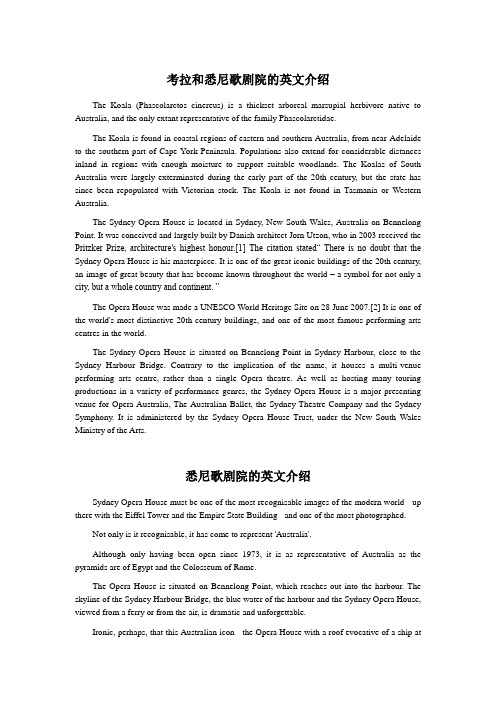
考拉和悉尼歌剧院的英文介绍The Koala (Phascolarctos cinereus) is a thickset arboreal marsupial herbivore native to Australia, and the only extant representative of the family Phascolarctidae.The Koala is found in coastal regions of eastern and southern Australia, from near Adelaide to the southern part of Cape York Peninsula. Populations also extend for considerable distances inland in regions with enough moisture to support suitable woodlands. The Koalas of South Australia were largely exterminated during the early part of the 20th century, but the state has since been repopulated with Victorian stock. The Koala is not found in Tasmania or Western Australia.The Sydney Opera House is located in Sydney, New South Wales, Australia on Bennelong Point. It was conceived and largely built by Danish architect Jørn Utzon, who in 2003 received the Pritzker Prize, architecture's highest honour.[1] The citation stated“ There is no doubt that the Sydney Opera House is his masterpiece. It is one of the great iconic buildings of the 20th century, an image of great beauty that has become known throughout the world – a symbol for not only a city, but a whole country and continent. ”The Opera House was made a UNESCO World Heritage Site on 28 June 2007.[2] It is one of the world's most distinctive 20th century buildings, and one of the most famous performing arts centres in the world.The Sydney Opera House is situated on Bennelong Point in Sydney Harbour, close to the Sydney Harbour Bridge. Contrary to the implication of the name, it houses a multi-venue performing arts centre, rather than a single Opera theatre. As well as hosting many touring productions in a variety of performance genres, the Sydney Opera House is a major presenting venue for Opera Australia, The Australian Ballet, the Sydney Theatre Company and the Sydney Symphony. It is administered by the Sydney Opera House Trust, under the New South Wales Ministry of the Arts.悉尼歌剧院的英文介绍Sydney Opera House must be one of the most recognisable images of the modern world - up there with the Eiffel Tower and the Empire State Building - and one of the most photographed.Not only is it recognisable, it has come to represent 'Australia'.Although only having been open since 1973, it is as representative of Australia as the pyramids are of Egypt and the Colosseum of Rome.The Opera House is situated on Bennelong Point, which reaches out into the harbour. The skyline of the Sydney Harbour Bridge, the blue water of the harbour and the Sydney Opera House, viewed from a ferry or from the air, is dramatic and unforgettable.Ironic, perhaps, that this Australian icon - the Opera House with a roof evocative of a ship atfull sail - was designed by renowned Danish architect - Jørn Utzon.In the late 1950s the NSW Government established an appeal fund to finance the construction of the Sydney Opera House, and conducted a competition for its design.Utzon's design was chosen. The irony was that his design was, arguably, beyond the capabilities of engineering of the time. Utzon spent a couple of years reworking the design and it was 1961 before he had solved the problem of how to build the distinguishing feature - the 'sails' of the roof.Sydney Opera House from the harbour, photo courtesy of Andrew WattsThe venture experienced cost blow-outs and there were occasions when the NSW Government was tempted to call a halt. In 1966 the situation - with arguments about cost and the interior design, and the Government withholding progress payments - reached crisis point and Jørn Utzon resigned from the project. The building was eventually completed by others in 1973.Sydney Opera House facts and figuresThe Sydney Opera house:Was designed by Danish architect Jørn Utzon.Was opened by Queen Elizabeth II on 20 October 1973.Presented, as its first performance, The Australian Opera's production of War and Peace by Prokofiev.Cost $AU 102,000,000 to build.Conducts 3000 events each year.Provides guided tours to 200,000 people each year.Has an annual audience of 2 million for its performances.Includes 1000 rooms.Is 185 metres long and 120 metres wide.Has 2194 pre-cast concrete sections as its roof.Has roof sections weighing up to 15 tons.Has roof sections held together by 350 kms of tensioned steel cable.Has over 1 million tiles on the roof.Uses 6225 square metres of glass and 645 kilometres of electric cable.SYDNEY, Australia-- Around every bend in Australia, there are natural beauties and magnificent vistas. But perhaps nothing identifies the country more than a breathtaking view of the Sydney Opera House.The Opera House, designed by Danish architect Jørn Utzon, is lauded by many as one of the architectural wonders of the modern world. It attracts 90 percent of tourists who visit Sydney and acts as a major home to the performing arts in Australia.Australian cuisineThe site of the opera house is some 500 yards from where the first European colonists landed in 1788. Fort Macquarie was established there at Bennelong Point in 1821. A tram depot came along in 1902. Trams were phased out in the 1950s, not long after Sydney Symphony Orchestra conductor Eugene Goossens began actively floating the idea of a concert hall. A government official seized on the concept and established an advisory committee, which selected the site of the old tram shed as the new home of the Sydney Opera House.In 1956, the government announced an international design competition. Utzon won the next year with his distinctive "soaring sails" vision of a harborside center. He said his idea for the structure had come from a simple source: the orange."All the shells are cut out of the same sphere," says Michael Lynch, chief executive of the Opera House Trust, "and now all have a common denominator."In an interesting aside, renowned American architect Frank Lloyd Wright didn't approve of the blueprints. "The circus tent is not architecture," Wright said.Reconciling with the architectConstruction of the Opera House took almost a decade and a half, and cost US $66 million, more than 14 times original projectionsConstruction began in 1959. It was supposed to take four years and cost $7 million Australian (US $4.7 million) -- to be paid from lottery revenues. That turned out to be an unrealistic figure."They went through extraordinary difficulty in trying to make the building work," Lynch says. "The sails themselves are all made out of pre-stressed concrete at a point where that was pretty much cutting-edge technology."Construction wasn't finished until 14 years later in 1973, with a $100 million Australian (US $66 million) price tag. Utzon didn't stick around for the completion. He left in 1966, disgusted with changes the New South Wales government wanted to make to his design -- as early as the first year of construction, for example, officials had demanded he double the number of performance spaces in the facility.Utzon vowed never to return. "I don't care if they pull the opera house down," he's reported to have said.The architect, now 81, apparently has had some change of heart over the years. The Sydney Morning Herald reports that he's agreed to help Australian architects upgrade the building. Thearticle says they'll travel to the Spanish island of Majorca to consult with Utzon on redesigning the interior to match the exterior. Utzon is not expected to come to Sydney for the project.Going for more than just concertsThe ceiling of the Opera House. The architect said the design concept came from an orange: 'Shells ... cut out of the same sphere'The complex boasts several performance halls that carry every genre of entertainment, from jazz to ballet. An estimated 3,000 performances each year are seen by about two million people."I think it's one of the great performance arts centers in the world," Lynch says. "The performing arts in Australia have blossomed, I think, largely because of the role that this building plays."Visitors are drawn to more than the performances. The complex holds cafes and shops, too. Today, more than 300,000 visitors tour the opera house each year.And with the eyes of the world turning to Australia for the year 2000 and its Summer Olympic Games there, it's a safe bet that the Sydney Opera House will remain the nation's true center stage.悉尼的英文简介Australia's premier city is the oldest settlement in Australia, the economic powerhouse of the nation and the country's capital, Canberra is everything but name. Built on the shores of the stunning Port Jackson, you would have to die and go to heaven before you see a more spectacular setting for a city. It's a vital, self-regarding metropolis, making itself a melting pot with people from all over the world.When to GoThe best times to visit are of spring and autumn, especially around March to April or October to November. Sydney is blessed with a temperate climate. Sometimes torrential downpours often break the heat between October and March. Winters are cool rather than cold. Beach lovers unperturbed by the hazards of lizard-skin should come between December and February.Sydney HarborThe harbor is the defining characteristic of the city. Its multiple sandstone headlands, dramatic cliffs, rocky islands and stunning bays and beaches, make it one of the most beautiful stretches of water in the world. Officially called Port Jackson, the harbor stretches some 20km inland to join the mouth of the Parramatta River. The most scenic area is on the ocean side of the bridge. The Sydney Harbor National Park protects the scattered pockets of bushland around the harbour and offers good walking tracks. The best way to experience the harbour is to go sailing, but if you're lacking nautical skills there are plenty of ways to enjoy it. Try catching the Manly ferry, swimming at Nielsen Park, walking from Manly to Spit Bridge, having a drink at Watsons Bay, dining with a view at Rose Bay, Balmoral or Circular Quay, or cruising to the heads on the Bounty.Sydney Opera HouseAustralia's most recognizable icon is dramatically situated on the eastern headland of Circular Quay. Its famous sail- and shell-like roofs were inspired by palm fronds, according to architect Jorn Utzon, but may remind you of turtles engaging in sexual congress. The Opera House is so unique that it has been photographed a zillion times, appears on an army of cheap t-shirts, every other Sydney postcard and decorates the frames of Dame Edna's dramatic glasses. It was built between 1959 and 1973, but plagued with construction delays and political difficulties which culminated in the resignation of Utzon in 1966. Although some visitors are disappointed by the interior, designed by a consortium of Australians after Utzon quit, it's a truly memorable place to see a performance or to sit at one of its outdoor cafes with a bottle of white wine and watch harbour life go by. The Opera House hosts theatre, classical music, ballet and film, as well as the seasonal opera performances. There is free music on the prow of the Opera House on weekends and a craft market on the forecourt on Sunday.The RocksThe Rocks is the oldest, quaintest part of Sydney. Today it is unrecognizable from the squalid, overcrowded and plague-ridden place it used to be. Reinvented by visionaries in the building industry and the trade union movement in the 1970s, the Rocks is now a sanitized, historical tourist precinct, full of cobbled streets, colonial buildings and stuffed koalas. If you ignore the kitsch, a stroll around the Rocks can be delightful. Attractions include the weekend market, the Earth Exchange geological and mining museum, and numerous craft shops and art galleries.But it's the old buildings, alleyways and historic facades that attract most visitors. Try exploring the less developed areas in the contiguous suburb of Millers Point, which has not sacrificed its community life to the tourist dollar. Check out the Lord Nelson Brewery Hotel and The Hero of Waterloo, two of Sydney's oldest pubs.Circular QuayCircular Quay is built around Sydney Cove and is considered by many to be the focal point of the city. The first European settlement in Australia grew around the Tank Stream which now runs underground into the harbour here. For many years this was the shipping centre of Sydney, but it's now both a commuting hub and a recreational space, combining ferry quays, a railway station and the Overseas Passenger Terminal with harbour walkways, restaurants, buskers, parks, the Museum of Contemporary Art and, of course, the Sydney Opera House.Macquarie StreetSydney's greatest concentration of early public buildings grace Macquarie St, many of them commissioned by Governor Macquarie and designed by the convict architect Francis Greenway. The most impressive are the elegant, two-storied Parliament House, Sydney Hospital, the Mint Building, the exquisite Hyde Park Barracks, St James Church and the voluminous State Library. The Barracks and the Mint are now museums, the library hosts exhibitions and there are tours of both the hospital and Parliament House. Macquarie St is the eastern boundary of the Central Business District and borders the Domain and the Royal Botanic Gardens. It runs from Hyde Park to Circular Quay.The Domain, Art Gallery & Botanic GardensThe Domain is a large grassy area east of Macquarie St which was set aside by Governor Phillip for public recreation. Today it is used by city workers for lunchtime sports and as a place to escape the bustle of the city. On Sunday afternoons, it's the gathering place for impassioned soapbox speakers, who do their best to entertain or enrage their listeners. It is also the venue for free events held during the festival of Sydney in January and the popular Carols by Candlelight at Christmas. The Art Gallery of New South Wales is in the northeast corner of the Domain. It hasexcellent permanent exhibitions of Australian, European, Japanese and tribal art, and has some inspired temporary exhibits.The Royal Botanic Gardens encompass Farm Cove, the first bay east of Circular Quay, and include the site of the colony's first vegetable patch. They contain a magnificent collection of South Pacific plant life, tropical displays in the Arc and Pyramid glasshouses, and a beautiful, old-fashioned formal rose garden. The spectacularly located gardens are a favoured spot for family picnics and wedding photographs.Darling HarbourThis huge waterfront tourist and leisure park comprises walkways, gardens, museums, an aquarium, convention centre, casino, eateries and shops. It was once a thriving dockland area, but it declined to the level of an urban eyesore before being reinvented as Darling Harbour in the 1980s by a combination of vision, planning, politicking, forbearance and huge amounts of cash. The emphasis is on casual fun and enjoyment of the kind appreciated by families with small children and coach tourists. The highlights are the Sydney Aquarium, the Australian National Maritime Museum, the water sculpture, the Chinese Garden, the massive IMAX cinema, and the nearby Powerhouse Museum, Sydney's most spectacular museum.Bondi BeachBondi Beach is the grand dame of Sydney's beaches with a magnificent sweep of sand and a never-ending series of majestic rollers crashing into the shallows. The suburb of Bondi Beach is an eclectic mix of ice cream parlours, designer cafes, greasy fish & chips joints, kosher shops and surf fashion stores. The seafront promenade and pavilion have been given a welcome facelift; car parking and fixing the offshore sewage outlets remain the only problems.Ku-Ring-Gai-Chase National Park[R-p6]Ku-Ring-Gai Chase National Park covers 150 sq km (60 sq mi) of sandstone bushland at the mouth of the Hawkesbury River, 24km (15mi) north of Sydney. The park has over 100km (60mi) of shoreline, plenty of forest and wildlife, a number of walking tracks and some magnificent Aboriginal rock art. Elevated parts of the park offer superb views across Pittwater towards the northernmost suburbs of Sydney.Royal National ParkThe Royal National Park, 35km (22mi) south of city, is the oldest gazetted national park in the world. The sea of low scrub which covered the sandstone plateau in the north of the park was devastated by the 1994 bushfires, but the forested river valleys and the beaches were unscathed. The park is dissected by the Hacking River and there are riverside picnic and boat hiring facilities at Audley. There's a spectacular 26km (16mi) coastal track stretching the length of the park, whichis accessible from Bundeena. It passes the lovely lagoon beach at Wattamolla, and the popular surfing spot at Garie Beach. The best views are from the southern boundary of the park overlooking Bulli from the edge of the Illawarra escarpment.Most visitors to Sydney arrive at Kingsford Smith airport. Airfares to Australia are expensive - it's a long way from anywhere and flights are often heavily booked. The most pleasant way to get around in Sydney is by ferry. A trip on the Manly Ferry is the best way to experience the harbor if you can't charm someone into taking you sailing. Major roads from Sydney go north to Newcastle, west to the Blue Mountains, south to Melbourne and Canberra and down the south coast to Wollongong.Anyway, you will certainly find this trip to Sydney Australia one of your most memorable experiences in your life. The trip will leave you sweet memories that you would like to share with your family and your friends.SydneySydney is an important commercial(商业的),industrial(工业的)and tourist centre on the southeast coast of Australia.It is Australia's largest city with a population of more than three million.The city has many famous sights.The harbour is one of the largest and most beautiful in the world and Sydney Harbour Bridge(悉尼港桥)—or“The Coathanger”as the people of Sydney call it—has been a great tourist attraction for many years.However,the most famous sight here nowadays is the Opera House(歌剧院).Some people think that it is one of the most beautiful modern buildings in the world.Sydney is a very modern city,but it also has many places of interest.In the areas called The Rocks and Paddington,for example,you can still see some of the first houses that were ever built here.For entertainment(娱乐),there is a lot to do here.The city has many different kinds of restaurants,theatres,cinemas and nightclubs.There is also a zoo and a Koala Bear Park.Some of the best beaches in Australia are here,too.Surfing(冲浪)is the most popular sport in Sydney.In fact,there are so many surfers in the city that you have to register surfboards here just like you have to register motorcars!问题补充:list the tourist attractions mentioned above( )give a title to the passage( )1.Sydney Harbour Bridge2.the Opera House3.The Rocks and Paddington4.a zoo and a Koala Bear Park5.different kinds of restaurants,theatres,cinemas and nightclubs.6.the best beachesTour in Sydney悉尼是一个重要的商业,工业,旅游的中心在澳大利亚的东南沿海。
悉尼歌剧院
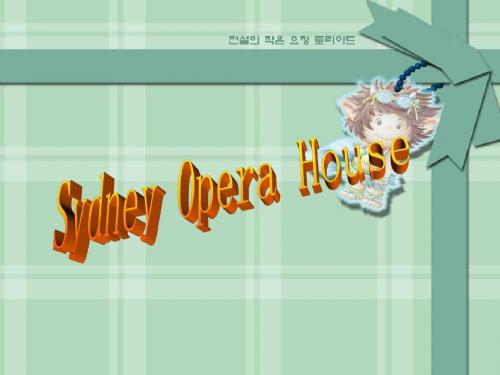
• Utzon's design was chosen. The irony was that his design was, arguably, beyond the capabilities of engineering of the time. Utzon spent a couple of years reworking the design and it was 1961 before he had solved the problem of how to build the distinguishing feature - the sails of the roof.
• Has an annual audience of 2 million for its performances. • Includes 1000 rooms. • • • • Are 185 meters long and 120 meters wide. Have 2194 pre-cast concrete sections as its roof. Has roof sections weighing up to 15 tons. Has roof sections held together by 350 kms of tensioned steel cable. • Has over 1 million tiles on the roof. • Uses 6225 square meters of glass and 645 kilometers of electric cable.
澳大利亚悉尼歌剧院观演攻略

澳大利亚悉尼歌剧院观演攻略悉尼歌剧院是世界著名的艺术建筑之一,也是澳大利亚最具代表性的地标之一。
无论是外观的壮丽,还是内部的宏伟,都给人留下深刻的印象。
对于喜爱艺术和音乐的人来说,悉尼歌剧院是一个不能错过的地方。
如果你打算前往悉尼歌剧院观演,下面是一些攻略,希望对你有所帮助。
1. 了解剧目在前往悉尼歌剧院之前,首先要了解当前的剧目安排。
悉尼歌剧院每年举办各类音乐会、歌剧、舞蹈以及戏剧演出,其中一些是定期上演的,如《卡门》、《魔笛》等;另一些则是特别的季节性演出。
提前了解剧目安排,可以选择自己感兴趣的演出,并合理安排行程。
2. 预订门票悉尼歌剧院是澳大利亚最受欢迎的旅游景点之一,门票常常供不应求。
为了确保观演的机会,建议提前预订门票。
可以通过悉尼歌剧院官方网站或者其他可信的在线票务平台进行预订。
预订时,要注意选择合适的座位区域和场次时间,以及确认票价和退换票政策。
3. 到达方式悉尼歌剧院位于悉尼市中心的悉尼港旁,交通便利。
无论是乘坐公交车、火车还是轮渡,都可以方便地到达。
如果你住在市区附近,建议选择步行或者乘坐公共交通工具前往,可以避免交通拥堵和停车问题。
如果你来自其他地区,可以选择乘坐长途巴士或者租车前往。
4. 观演前的准备观演前,建议提前安排好晚餐或者轻食。
悉尼歌剧院内设有餐厅和咖啡厅,但由于观演结束后可能有一段时间排队等候离场,因此提前解决好饮食问题,可以让你更好地享受观演过程。
此外,还要提醒一点,观演时要遵守场馆规定。
不要携带大件行李或者危险物品,要保持安静,手机静音。
如果是观看长时间演出,也可以带一些小零食或者水。
在国际巡演或者特别节目上演时,建议提前了解场馆的额外要求和安排。
5. 游览悉尼歌剧院除了观看演出,你还可以参加悉尼歌剧院的导览活动。
导览活动通常持续一小时左右,可以让你更加深入地了解悉尼歌剧院的历史和建筑特点。
导览过程中,你将有机会进入主舞台和观众席区域,近距离感受悉尼歌剧院的壮丽和神奇。
游览悉尼 歌剧院演出一览

游览悉尼歌剧院演出一览悉尼歌剧院是世界著名的建筑之一,也是澳大利亚最具代表性的地标之一。
这座壮丽的建筑吸引了无数游客,他们不仅来此参观,还可以欣赏到世界级的演出。
本文将为您介绍一下悉尼歌剧院的演出一览,为您提供更多了解这个令人神往的地方的机会。
1. 歌剧院概况悉尼歌剧院位于澳大利亚悉尼港湾,是丹麦著名建筑师小堡·海恩设计的杰作。
作为世界最重要的表演艺术中心之一,它拥有多个演出场地,每年吸引着来自世界各地的优秀表演团体和艺术家。
游客可以参观内部的剧院大厅、舞台和排练场地,领略音乐之殿的魅力。
2. 演出节目悉尼歌剧院每年都会有丰富多样的演出节目供观众选择。
以下是近期的一些精彩演出:- 歌剧:作为悉尼歌剧院的代表性节目,各种经典歌剧作品在这里上演。
像《卡门》、《弄臣》、《图兰朵》等都曾在这里上演过,让歌剧迷们流连忘返。
- 交响乐:悉尼歌剧院还定期举办交响乐音乐会,邀请世界一流的乐团和指挥家来此演出。
无论是贝多芬、柴可夫斯基还是马勒的作品,都将在这里展现出最好的演绎。
- 跳舞:悉尼歌剧院的舞蹈节目也备受瞩目,来自世界各地的杰出舞团在这里展示出精湛的技艺和灵动的舞姿。
华丽的芭蕾舞剧和现代舞作品,都将给观众带来震撼的视觉享受。
- 戏剧表演:除了歌剧和音乐会,悉尼歌剧院还举办各种戏剧表演。
包括戏剧剧目、儿童剧和话剧等,适应不同观众群体的喜好和需求,带给他们截然不同的表演体验。
3. 演出场地在悉尼歌剧院,有多个不同规模和功能的室内演出场地,以满足不同演出节目的需求:- 歌剧院大剧院:是最重要的演出场地,能容纳1507名观众。
它的优雅和独特的设计使得观众能够在舒适的环境中欣赏到最高水准的演出。
- 歌剧院小剧场:作为大剧院的附属场地,小剧场可容纳400名观众。
在这里,观众可以近距离观赏到演员的表演,与他们建立更亲密的连接。
- 歌剧院副剧场:较小的副剧场适合举办小规模的演出和观摩课程,为演员和观众提供更加亲密和深入的交流空间。
澳大利亚悉尼歌剧院参观攻略

澳大利亚悉尼歌剧院参观攻略悉尼歌剧院(Sydney Opera House)位于澳大利亚悉尼市中心的贝内省港湾,是世界上最具标志性的建筑之一。
设计灵感源自天鹅的展开翅膀,它的独特形态和壮观建筑吸引了世界各地的游客前来参观。
如果您计划参观悉尼歌剧院,这里有一些攻略,帮助您充分欣赏这个世界级建筑的美丽魅力。
1. 预订门票参观悉尼歌剧院前,首先需要预订门票。
您可以通过官方网站或者当地旅行社进行预订。
建议提前预订,特别是在旅游旺季来临之前,以确保您能够在合适的时间参观。
2. 参观时间悉尼歌剧院全年开放,但参观时间根据季节和活动安排而有所不同。
在预订门票之前,最好确认开放时间以及是否有特殊活动正在进行。
参观时应尽量选择风和日丽的天气,让您能够更好地欣赏到歌剧院的美景。
3. 参观路线悉尼歌剧院提供多种参观路线,您可以选择您最感兴趣的一种。
典型的参观路线包括外部游览和内部探索。
在外部游览中,您可以欣赏到歌剧院壮丽的外观,并在海港边享受绝佳的视野。
而内部探索则会带您深入了解歌剧院的建筑设计和其背后的故事。
4. 周边活动悉尼歌剧院周边还有很多其他的活动供您参与。
您可以欣赏世界级的表演,例如音乐会、歌剧、戏剧和舞蹈等。
此外,您还可以参加导览课程,了解更多有关歌剧院的背景知识。
5. 安全须知参观悉尼歌剧院时,注意自身安全是非常重要的。
遵守导游的规定和指示,不要脱离团队单独行动。
另外,悉尼歌剧院内有禁止拍摄的区域,您需要遵守相关规定,尊重艺术家和观众的权益。
悉尼歌剧院是一座让人心驰神往的建筑,其建筑风格和艺术内涵都值得我们去探索。
通过提前计划和预订门票,您可以轻松而愉快地参观这座世界级的建筑,并参与到悉尼歌剧院的激动人心的活动中来。
希望您在悉尼的旅行中能够留下美好的回忆!。
澳大利亚悉尼歌剧院

澳大利亚悉尼歌剧院澳大利亚悉尼歌剧院位于澳大利亚悉尼市中心的邻近滨水地区,是世界上最著名的歌剧院之一,也是澳大利亚的标志性建筑之一。
它以其独特的建筑风格、卓越的音乐表演和丰富的文化活动而闻名,成为许多游客和音乐艺术爱好者梦想的目的地。
1. 建筑风格悉尼歌剧院的建筑风格独特而引人注目。
它由丹麦建筑师于尔根·乌兹勒设计,充分展现了现代主义建筑的特点。
歌剧院的整体外观采用白色建筑材料,由一系列混凝土壳构成,给人一种优雅而流线型的感觉。
每个壳体都呈扇形,如同帆船的船帆,顶端相互交叠,形成了独特的建筑形态,成为悉尼市天际线的标志。
2. 音乐表演悉尼歌剧院是世界上最重要的音乐表演场所之一,每年吸引了大量的国内外著名音乐家和乐团进行演出。
歌剧院内设有多个演出厅,包括歌剧院大厅、音乐厅、戏剧院等等。
这些不同规模的演出厅能够容纳不同类型的音乐和表演,满足观众的各种需求。
在这里,观众可以欣赏到世界级的交响乐、歌剧、舞蹈和戏剧演出,享受到高品质的音乐艺术盛宴。
3. 文化活动除了音乐表演外,悉尼歌剧院还举办多种多样的文化活动,如展览、讲座、儿童剧场和工作坊等。
这些活动不仅让观众能够更深入地了解音乐艺术,还提供了一个平台,让人们能够亲身参与到艺术创作的过程中。
无论是年轻人还是老年人,无论是艺术爱好者还是普通观众,都可以在这里找到属于自己的文化体验。
4. 旅游景点悉尼歌剧院也是一个重要的旅游景点,每年吸引数百万的游客前来参观。
游客可以选择参加导览活动,了解歌剧院的历史和背后的故事,同时欣赏到壮观的建筑和内部装饰。
此外,歌剧院所处的位置也让游客可以欣赏到美丽的海港景色,拍摄壮丽的照片,留下难忘的回忆。
5. 社区贡献除了在文化和旅游领域的贡献外,悉尼歌剧院还积极参与社区活动,推动当地文化的发展。
它支持本地艺术团体和青年艺术家,举办社区音乐会和艺术节,为当地居民提供更多参与艺术的机会。
悉尼歌剧院致力于成为一个与社区密切联系和互动的文化中心。
悉尼歌剧院
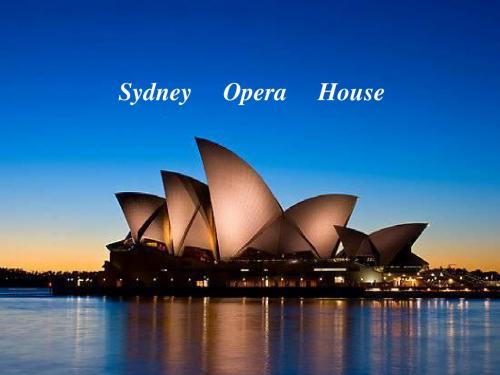
Opera
House
Location
History
Design and Features
Function
Accomplishment
Reputation
Location
The Sydney Opera House is situated on Benne long Point in Sydney Harbor, close to the Sydney Harbor Bridge. It sits at the north-eastern tip of the Sydney central business district (the CBD), surrounded on three sides by the harbor (Sydney Cove and Farm Cove), and neighbored by the Royal Botanic Gardens.
Function
The Concert Hall: It's the biggest hall which can
accommodate 2679 specters, is often used to hold symphony, jazz, chamber music and other performances. The Opera Theatre: 1547seats used for Opera Australia and ballet. The Drama Theatre: 544seats , is used by the Sydney Theatre Company and other dance and theatrical presenters. The PlayHouse: is an end stage theatre with 398 seats. The Studio : a flexible space with a maximum capacity of 400 people , depending on configuration.
悉尼歌剧院攻略

悉尼歌剧院攻略简介悉尼歌剧院(Sydney Opera House)是澳大利亚悉尼的一个标志性建筑,也是世界上最著名的建筑之一。
它位于悉尼港的珍宝岛上,是世界上最美丽的建筑之一,也是悉尼最著名的旅游景点之一。
本文旨在为游客提供悉尼歌剧院的攻略,包括参观信息、表演信息以及周边景点推荐等内容。
参观信息地址及开放时间悉尼歌剧院位于悉尼港的珍宝岛上,地址为Bennelong Point, Sydney NSW 2000, Australia。
悉尼歌剧院每天都对游客开放,具体开放时间如下: - 星期一至星期四:9:00 AM - 5:00 PM - 星期五至星期日:9:00 AM - 6:00 PM参观方式游客可以通过以下方式参观悉尼歌剧院: 1. 自行游览:游客可以自行购票参观悉尼歌剧院,票价为成人AUD 42.5,学生及儿童可享受优惠票价。
在参观过程中,游客可以逐个拜访悉尼歌剧院的各个剧院、大厅和展览空间,了解其建筑风格和历史背景。
2. 导览服务:悉尼歌剧院提供导览服务,导游会带领游客参观悉尼歌剧院的各个亮点区域,并讲解其背后的故事和历史。
导览服务分为常规导览和专题导览两种,费用略高于自行游览。
参观建议•提前预订:由于悉尼歌剧院的知名度和游客数量较多,建议提前预订门票,以免排队等候。
•注意服装:参观时,建议穿着舒适的鞋子,因为需要步行一段时间。
另外,悉尼的气温变化较大,建议根据天气情况穿着合适的服装。
•了解演出信息:如果有兴趣观看演出,建议提前了解演出时间和购票信息,以便安排行程。
表演信息悉尼歌剧院以其世界级的表演而闻名,每年吸引着大量的观众。
以下是一些常见的表演类型: 1. 歌剧和音乐剧:悉尼歌剧院定期上演一些世界著名的歌剧和音乐剧,包括《魔笛》、《卡门》等。
这些表演通常由世界级的演员和乐团呈现,给观众带来极高的艺术体验。
2. 音乐会:悉尼歌剧院还举办各类音乐会,包括古典音乐、爵士乐、摇滚乐等。
悉 尼 歌 剧 院
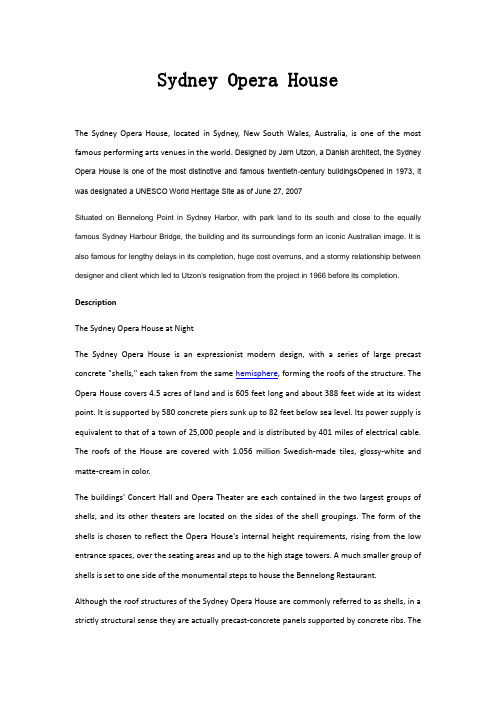
Sydney Opera HouseThe Sydney Opera House, located in Sydney, New South Wales, Australia, is one of the most famous performing arts venues in the world. Designed by Jørn Utzon, a Danish architect, the Sydney Opera House is one of the most distinctive and famous twentieth-century buildingsOpened in 1973, it was designated a UNESCO World Heritage Site as of June 27, 2007Situated on Bennelong Point in Sydney Harbor, with park land to its south and close to the equally famous Sydney Harbour Bridge, the building and its surroundings form an iconic Australian image. It is also famous for lengthy delays in its completion, huge cost overruns, and a stormy relationship between designer and client which led to Utzon's resignation from the project in 1966 before its completion. DescriptionThe Sydney Opera House at NightThe Sydney Opera House is an expressionist modern design, with a series of large precast concrete "shells," each taken from the same hemisphere, forming the roofs of the structure. The Opera House covers 4.5 acres of land and is 605 feet long and about 388 feet wide at its widest point. It is supported by 580 concrete piers sunk up to 82 feet below sea level. Its power supply is equivalent to that of a town of 25,000 people and is distributed by 401 miles of electrical cable. The roofs of the House are covered with 1.056 million Swedish-made tiles, glossy-white and matte-cream in color.The buildings' Concert Hall and Opera Theater are each contained in the two largest groups of shells, and its other theaters are located on the sides of the shell groupings. The form of the shells is chosen to reflect the Opera House's internal height requirements, rising from the low entrance spaces, over the seating areas and up to the high stage towers. A much smaller group of shells is set to one side of the monumental steps to house the Bennelong Restaurant.Although the roof structures of the Sydney Opera House are commonly referred to as shells, in a strictly structural sense they are actually precast-concrete panels supported by concrete ribs. Thebuilding's interior is composed of pink granite quarried in Tarana and wood and brush box plywood supplied from northern New South Wales.Performance venues and facilitiesThe Sydney Opera House contains five theaters, five rehearsal studios, two main halls, four restaurants, six bars, and numerous souvenir shops.The five theaters making up the performance facilities are:∙The Concert Hall, with 2,679 seats, contains the Sydney Opera House Grand Organ, the largest, mechanical-tracker-action organ in the world with over 10,000 pipes.The maximum seating capacity is 2,679 with approximately 2,100 seats situated in front of the stage (most appropriate for amplified concerts). The concert platform is 14m to 17m wide x 11m deep with a floor area of approximately 200m2. Stage extensions can be added to increase stage depth with the loss of 85 seats. Stage access and wing space are limited.∙The Opera Theater, with 1,547 seats.The maximum seating capacity is 1,507, with 883 in the stalls, 466 in the dress circle and 158 in boxes, some of which have restricted sightlines. The walls and ceiling are painted black and the floor is brushbox timber. The seats are made of white birch timber and are upholstered in red woollen fabric.The Opera Theatre has an extensive flying system and a maximum proscenium opening of 11.5m wide by 7.0m high. The height to the grid is 15.5m.The stage is 17.5m deep upstage of the safety curtain. Two lifts at the rear of the stage can add 7m to the stage depth and are used to move scenery from the dock area below.The orchestra pit extends in an arc downstage of the safety curtain to a maximum depth of 3m. The front section of the pit can be raised to stage level to increase the performance area. Wing space is restricted with only 3.5m beyond the proscenium on either side of the stage.∙The Drama Theater, with 544 seats.The maximum seating capacity is 544 in 19 rows.The auditorium is raked from the fourth row, ensuring good sightlines from all seats. Thewalls and ceiling are painted black and the floor is covered with blue carpet. The seats are made of white birch timber and are upholstered in tangerine woollen fabric.The Drama Theatre is equipped with a computerised flying system and twin concentric stage revolves (centre and ring). The maximum proscenium opening is 13.5m wide by4.8m high. The height to the grid is limited to 10.4m. The stage is 14m deep upstage ofthe safety curtain with a forestage of 2m.∙The Playhouse, with 398 seats.The maximum seating capacity is 398 in 17 rows. The fully raked auditorium ensures good sightlines from all seats. The walls and ceiling are clad in white birch timber and the floor is covered with red carpet. The seats are made of white birch timber and are upholstered in dark purple woollen fabric.The venue is designed in an ‘end stage’ configuration. The A-symmetric stage can be extended in two stages, ‘half extension’ and ‘fully extended’. Each extension adds approximately 90cm to the depth of the stage and requires the removal of up to 23 seats.The stage area has a maximum depth of 8.6m with the stage fully extended and a usable width of approximately 10m (widest point is 13.6m). Twenty motorised battens are available above the stage for rigging lighting and scenery to a maximum height of 6.4m plus a single stick of tri-truss down stage on chain motors. The stage surface is masonite covering plywood that can be screwed into.∙The Studio Theatre, with 364 seats.The maximum capacity ranges from 220 to 350 seated, or up to 600 standing, depending on the venue and seating layout.The floor area is approximately 15m x 15m, within which tiered seating bank/s, cabaret-style seating and a standing audience may be arranged in various configurations.There are two rows of fixed seating on each of the four sides on the gallery level Construction historyOrigins:Planning for the Sydney Opera House began in the late 1940s when Eugene Goossens, the Director of the New South Wales (NSW) State Conservatorium of Music, lobbied for a suitable venue for large theatrical productions. At the time, the normal venue for such productions was the Sydney Town Hall, but it was not considered large enough. By 1954, Goossens succeeded ingaining the support of NSW Premier Joseph Cahill, who called for designs for a dedicated opera house. It was also Goossens who insisted that Bennelong Point be the site for the Opera House. Cahill had wanted it to be on or near the Wynyard Railway Station, located in the north-western Sydney.The competition was launched by Cahill on September 13, 1955 and received a total of 233 entries from 32 countries. The criteria specified a large hall seating 3,000 and a small hall for 1,200 people, each to be designed for different uses including full-scale operas, orchestral and choral concerts, mass meetings, lectures, ballet performances, and other presentations. The basic design announced in 1957 was the one submitted by Jørn Utzon, a Danish architect. Utzon arrived in Sydney in 1957 to help supervise the project.Design and construction of the Opera HouseThe Fort Macquarie Tram Depot, occupying the site at the time of these plans, was demolished in 1958, and formal construction of the Opera House began in March 1959. The project was built in three stages. Stage I (1959–1963) consisted of building the upper podium. Stage II (1963–1967) saw the construction of the outer shells. Stage III consisted of the interior design and construction (1967–1973).Stage I: podiumStage I commenced on December 5, 1958, by the construction firm Civil & Civic. However, major structural issues still plagued the design, and inclement weather further delayed progress. By January 23, 1961, work was running 47 weeks behind. Work on the podium was finally completed on August 31, 1962. The forced early start led to significant later problems, not least of which was the fact that the podium columns were not strong enough to support the roof structure, and had to be re-built.Stage II: roofThe shells of the competition entry designed were originally of undefined geometry, but early in the design process the "shells" were perceived as a series of parabolas supported by precast-concrete ribs. However, engineers Ove Arup and partners were unable to find anacceptable method of constructing them. From 1957 to 1963, the design team went through at least 12 iterations or repetitions of the form of the shells (including schemes with parabolas, circular ribs, and ellipsoids) before a workable solution was completed.The design work on the shells involved one of the earliest uses of computers in structural analysis in order to understand the complex forces to which the shells would be subjected. In mid-1961, the design team found a solution to the problem: the shells all being created as sections from a sphere. With whom exactly this solution originated has been the subject of some controversy. The shells were constructed by Hornibrook Group Pty Ltd., who were also responsible for construction of the interiors in Stage III. Hornibrook manufactured the 2,400 precast ribs and 4,000 roof panels in an on-site factory, and also developed the construction processes. This solution avoided the need for expensive formwork construction by allowing the use of precast units and allowed the roof tiles to be prefabricated in sheets on the ground, instead of being stuck on individually at height. An Ove Arup and Partners' site engineer supervised the construction of the shells, which used an innovative adjustable steel trussed erection arch to support the different roofs before completion.Stage III: interiorsStage III, the interiors, started with Utzon moving his entire office to Sydney in February 1963. However, there was a change of government in 1965, and the new administration declared the project under the jurisdiction of the Ministry of Public Works. This ultimately led to Utzon's resignation.The second stage of construction was still in process when Utzon resigned. His position was principally taken over by Peter Hall, who became largely responsible for the interior design. Other persons appointed that same year to replace Utzon were E.H. Farmer as government architect, D.S. Littlemore, and Lionel Todd.In 1966, following Utzon's resignation, acoustic adviser Lothar Cremer confirmed that Utzon's original acoustic design only allowed for 2,000 seats in the main hall. He further stated that increasing the number of seats to the intended 3,000 would be disastrous for the acoustics. The subsequent Todd, Hall, and Littlemore versions of both major halls have indeed involved someproblems with acoustics, particularly for the performing musicians. The orchestra pit in the Opera Theater is cramped and making it difficult for musicians to hear, and the Concert Hall has a very high roof, creating other acoustic problems which have not been entirely solved.The Opera House was formally completed in 1973, having cost $102 million. The original cost estimate in 1957 was $7 million, and the original completion date set by the government was January 26, 1963.The Utzon controversyBefore the Sydney Opera House competition, Utzon had won seven of the 18 competitions he had entered, but had never seen any of his designs built. Utzon's submitted concept for the Sydney Opera House was almost universally admired and considered groundbreaking.For the first stage of the project Utzon worked successfully with the rest of the design team and the client, but as the project progressed, it became clear that the competition requirements had been inadequate with regard to acoustics, specifications of performance spaces, cost, and other issues. Tensions between the client and the design team grew further when an early start to construction was demanded, despite an incomplete design.Beginning in the late 1990s, the Sydney Opera House Trust began to communicate with Jørn Utzon in an attempt to effect a reconciliation, and to secure his involvement in future changes to the building. In 1999, he was appointed by the Sydney Opera House Trust as a design consultant for future work. In 2004, the first interior space rebuilt to match Utzon's original design was opened, and renamed "The Utzon Room" in his honor.悉尼歌剧院悉尼歌剧院、位于悉尼、澳大利亚、新南威尔士州是世界最著名的艺术表演场地之一。
悉尼歌剧院
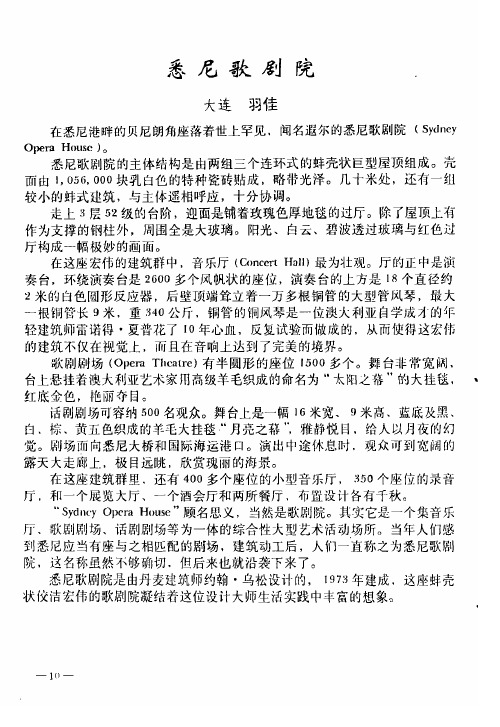
尼
歌
剧 羽佳
,
院
大连
在悉 尼 港 畔 的 贝尼 朗角 座 落着 世 上 罕 见
o
闻名 遐 尔 的悉 尼 歌 剧 院
( S yd
e n
y
r e a p
!
H`
〕Ll s c
悉 尼 歌剧院 的 主 体结构是 由两 组 三 个连环式 的 蚌壳状 巨 型 屋顶 组 成 面由
,
o
邪
3
,
0
0
52
块乳 白色 的 特种 瓷 砖贴 成
,
厅 构成 一 幅极 妙的 画 面 在这 座 宏伟 的 建筑群 中
0
,
。
,
)
。
,
,
,
,
,
,
,
。
。
,
“
”
,
9 J 米宽 名 观众 舞 台上 是 一 幅 6 米高 蓝 底及 黑 白 棕 黄 五 色 织 成 的羊毛大挂毯 月亮 之 幕 汽 雅静悦 日 给人 以 月夜的幻 觉 剧场 而 向悉 尼 大 桥 和 国 际 海 运 港 口 演 出中途休息时 观 众 可 到宽 阔 的 露 天 大走廊 上 极 目远眺 欣赏瑰 丽 的海景 3 在这 座 建筑群 里 还有 4 0 多个 座 位 的小 型 音 乐 厅 的 个 座 位 的录 音 厅 和 一 个 展 览 大 厅 一 个 酒 会 厅 和 两所 餐 厅 布置 设 计 各有千秋 s州 叮 o r ( a e l H 川s 顾 名思 义 当然 是 歌剧院 其实它是 一 个集音 乐 厅 歌 剧剧场 话剧剧场等为 一 体 的 综合性 大型 艺术活动场所 当年人们感 到 悉 尼 应当有座与 之 相 匹 配的剧场 建筑 动 工 后 人 们 一 直称 之 为悉 尼 歌剧 院 这名称 虽 然 不 够确切 但后来也就 沿 袭 下 来 了 19 73 悉尼歌剧院是 由丹麦建筑 师约翰 乌松设计的 年建成 这座蚌壳 状 佼洁宏伟 的歌 剧院凝结着这位 设 计大师生活实践 中丰富 的想 象
澳大利亚悉尼歌剧院参观攻略
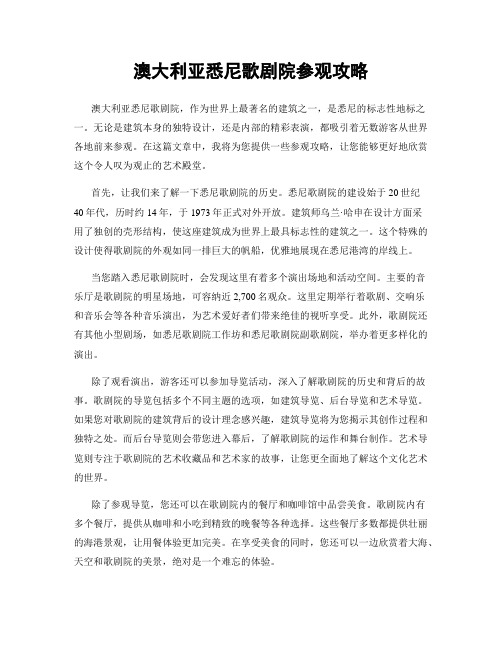
澳大利亚悉尼歌剧院参观攻略澳大利亚悉尼歌剧院,作为世界上最著名的建筑之一,是悉尼的标志性地标之一。
无论是建筑本身的独特设计,还是内部的精彩表演,都吸引着无数游客从世界各地前来参观。
在这篇文章中,我将为您提供一些参观攻略,让您能够更好地欣赏这个令人叹为观止的艺术殿堂。
首先,让我们来了解一下悉尼歌剧院的历史。
悉尼歌剧院的建设始于20世纪40年代,历时约14年,于1973年正式对外开放。
建筑师乌兰·哈申在设计方面采用了独创的壳形结构,使这座建筑成为世界上最具标志性的建筑之一。
这个特殊的设计使得歌剧院的外观如同一排巨大的帆船,优雅地展现在悉尼港湾的岸线上。
当您踏入悉尼歌剧院时,会发现这里有着多个演出场地和活动空间。
主要的音乐厅是歌剧院的明星场地,可容纳近2,700名观众。
这里定期举行着歌剧、交响乐和音乐会等各种音乐演出,为艺术爱好者们带来绝佳的视听享受。
此外,歌剧院还有其他小型剧场,如悉尼歌剧院工作坊和悉尼歌剧院副歌剧院,举办着更多样化的演出。
除了观看演出,游客还可以参加导览活动,深入了解歌剧院的历史和背后的故事。
歌剧院的导览包括多个不同主题的选项,如建筑导览、后台导览和艺术导览。
如果您对歌剧院的建筑背后的设计理念感兴趣,建筑导览将为您揭示其创作过程和独特之处。
而后台导览则会带您进入幕后,了解歌剧院的运作和舞台制作。
艺术导览则专注于歌剧院的艺术收藏品和艺术家的故事,让您更全面地了解这个文化艺术的世界。
除了参观导览,您还可以在歌剧院内的餐厅和咖啡馆中品尝美食。
歌剧院内有多个餐厅,提供从咖啡和小吃到精致的晚餐等各种选择。
这些餐厅多数都提供壮丽的海港景观,让用餐体验更加完美。
在享受美食的同时,您还可以一边欣赏着大海、天空和歌剧院的美景,绝对是一个难忘的体验。
悉尼歌剧院不仅是一个文化艺术的重要场所,也是一个社区和教育中心。
许多教育项目和社区活动在这里展开,为当地居民和学生提供了一个深入了解艺术和文化的机会。
悉尼歌剧院2
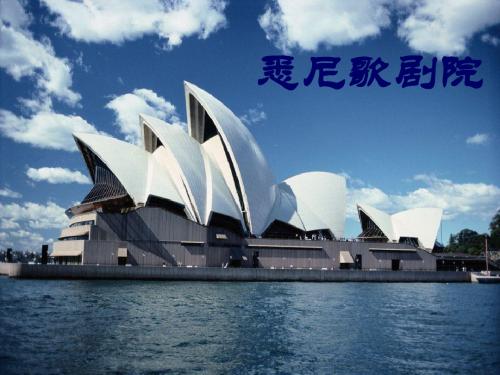
悉尼歌剧院不仅外观漂亮,而且它的 内部结构科学,设备讲究。它共有4个大 厅:音乐厅有2690个座位,音响效果非 常好,还有1550个座位的歌剧厅,550 个座位的戏剧厅和电影厅。舞台上的灯 光都是用计算机控制的,监控舞台的是 闭路电视系统。其他的像接待厅、陈列 厅、排练场、图书馆、咖啡馆等大小厅 室就更多了,一共有900多间呢!
悉尼歌备讲 究。
悉尼歌剧院是一位38岁的丹麦 建筑师设计的。剧院从1959年开始 兴建,整整用了14年。1973年10 月20日,悉尼歌剧院终于落成了。
悉尼歌剧院不仅外 观漂亮,而且它的内 部结构科学,设备讲 究。
这座造型别致的歌剧院, 三面临海,与远处雄伟的 悉尼大桥互相衬托,简直 是巧夺天工。
整座建筑洁白晶莹, 像一瓣一瓣盛开的白莲, 又像几叶张开的扇贝, 再仔细一看,更像一组 要出海远航而扬起的白 帆。
悉尼歌剧院不仅外观漂亮,而且它的 内部结构科学,设备讲究。它共有4个大 厅:音乐厅有2690个座位,音响效果非 常好,还有1550个座位的歌剧厅,550 个座位的戏剧厅和电影厅。舞台上的灯 光都是用计算机控制的,监控舞台的是 闭路电视系统。其他的像接待厅、陈列 厅、排练场、图书馆、咖啡馆等大小厅 室就更多了,一共有900多间呢!
整座建筑洁白晶莹, 像一瓣一瓣盛开的白莲, 又像几叶张开的扇贝, 再仔细一看,更像一组 要出海远航而扬起的白 帆。
悉尼歌剧院有着独特、 美丽的外形:整座建筑洁 白晶莹,像( ),又像 ( ),再仔细一看,更 像( )。
三面临海 ( )
(1)到
(√2)挨着,靠近
(3)照着字、画模仿
三面临海
这座造型别致的歌剧院,三 面临海,与远处雄伟的悉尼大桥 互相衬托,简直是巧夺天工。
悉尼歌剧院攻略

悉尼歌剧院攻略悉尼歌剧院是澳大利亚最具代表性的建筑之一,也是悉尼市的标志性景点。
无论是外观设计还是内部设施,歌剧院都吸引了无数游客的目光。
以下是关于悉尼歌剧院的攻略,帮助您更好地了解和欣赏这一著名的建筑。
一、背景介绍悉尼歌剧院位于悉尼市中心的悉尼港边,是由丹麦建筑师乌杰尔霍尔和英国建筑师普劳特曼联手设计建造的。
该建筑于1973年落成并对外开放,拥有多个独特的展厅和演出场地,是世界上最重要的表演艺术中心之一。
二、参观信息1. 开放时间悉尼歌剧院每天都对游客开放,具体开放时间为早上9点至晚上5点。
游客可以提前了解具体的演出时间表,根据自己的兴趣选择进行游览或观看演出。
2. 购票方式游客可以通过官方网站或现场票房购买门票。
建议提前预订,特别是在节假日或热门演出时段,以避免排队等候或无法购买到心仪的票。
3. 导览服务悉尼歌剧院提供导览服务,游客可以选择参加定时导览或者自助导览。
导览中会向游客详细介绍歌剧院的历史、设计和演出情况,是了解歌剧院的最佳方式之一。
4. 餐饮设施歌剧院内设有多个餐厅和咖啡馆,供游客休息和用餐。
您可以在观赏演出之前或参观之后享用美食,欣赏悉尼港的壮丽景色。
三、演出体验1. 演出类型悉尼歌剧院每年都会举办各类演出,包括歌剧、戏剧、音乐会等。
您可以提前查看演出计划并购票,亲身体验世界一流的表演艺术。
2. 票价和座位选择不同演出的票价和座位选择有所不同。
建议提前了解所选演出的票价范围,并根据个人喜好选择座位。
部分演出会提供特殊票价,如学生票或团体票,具体信息可以向歌剧院官方咨询。
3. 注意事项在观看演出时,请遵守歌剧院的演出礼仪和规定,关闭手机或将其调至静音模式,不要在演出过程中拍照、录音或录像,以免干扰表演和其他观众的体验。
四、周边景点推荐1. 悉尼港大桥位于悉尼歌剧院对面的悉尼港大桥是另一个标志性景点,游客可以步行或搭乘渡轮前往,观赏悉尼港美丽的风景。
2. 悉尼歌剧院附近的公园悉尼歌剧院周边有多个公园,如皇家植物园和玛丽女王陵园,游客可以在漫步中享受自然美景,并欣赏到悉尼歌剧院不同角度的独特风光。
